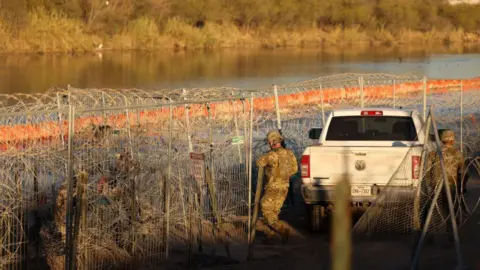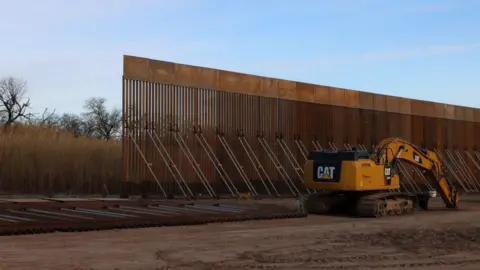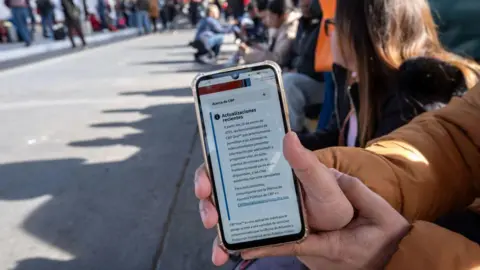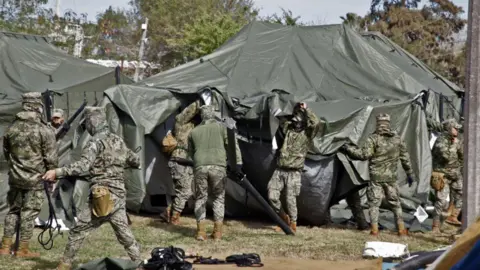Six big immigration changes under Trump - and their impact so far
Since taking office on 20 January, President Donald Trump has announced a flurry of immigration-related executive orders, paving way for a widespread effort to crack down on undocumented migrants in the US.
In more than 21 actions, Trump has moved to overhaul parts of the US immigration system, including how migrants are processed and deported from the US.
The White House has since publicised some of these efforts. On Friday, the new White House Press Secretary shared images of deportation flights being carried out by military cargo planes.
While Trump has promised "mass deportations" and arrests, it remains unclear how much of his plan is already being implemented.
Here is a breakdown of some of the significant actions taken by Trump on immigration in his first week, and how they compare to past policies.
Deportation of migrants
A cornerstone of Trump's immigration policy is removing unlawful migrants out of the US and the promise of "mass deportations".
To that effect, the defence department has said that it will provide military aircraft to deport more than 5,000 people that have been detained by Border Patrol in San Diego and El Paso, Texas.
ICE statistics show that over 1,000 people were removed or repatriated on Thursday, the fourth day of the Trump administration.
Border czar Tom Homan has vowed that the deportations would increase steadily going forward.
Over the weekend, Trump's deportation flights caused a brief diplomatic spat after Colombia's government barred two military planes carrying Colombians deported from the US from landing.
The country's president, Gustavo Petro, said that "the US can't treat Colombian migrants like criminals" and that they need to be "treated with dignity".
His government, however, appears to have agreed to accept the flights after the Trump administration threatened Colombia with punitive tariffs.
Trump has also moved to expand the scope of expedited deportations of undocumented migrants, reviving a policy under his first term that Biden had discontinued.
- Trump has vowed to end birthright citizenship. Can he do it?
- From snowy cities to Mexican border - Trump deportations loom
- 'No choice but to go back' - migrants despair over Trump border restrictions
Expedited removals were previously limited to areas within 100 miles (160km) of US international borders, and applied to those who did not request asylum or failed to show a legitimate case for asylum.
With Trump's changes, these removals can now occur anywhere in the US, and will apply to undocumented migrants who can't prove that they have been in the country for more than two years.
Deportations are not unique to the Trump administration.
Biden carried out deportations as well, with 271,000 immigrants deported to 192 countries in fiscal year 2024.
In total, Biden carried out 1.5 million deportations in his four years, according to figures by the Migration Policy Institute. That is around the same that was carried out under Trump's first term.
That number is lower than deportations carried out under Barack Obama's first term, which added up to a total of 2.9 million.
 Getty Images
Getty ImagesFortifying the US-Mexico border
The Pentagon announced on Wednesday the deployment of 1,500 active duty troops to the southern US border. This is in addition to 2,500 active-duty personnel already there, officials said - marking a 60% increase in Army troops in the area.
The troops will fly helicopters to help Border Patrol agents with monitoring, said acting Defense Secretary Robert Salesses. They will also help in the construction of barriers to stop migrants from coming in.
Salesses signalled that "this is just the beginning" and more troops may be sent soon.
Officials added that a number of additional "border enforcement missions" are in development, without providing specifics.
Biden also deployed active-duty troops to the border, which were used to assist Border Patrol with primarily administrative tasks ahead of the expiration of Title 42, a public health order that was used to expel migrants quickly during Covid-19.
Border crossings significantly dropped in Biden's final year as president. In December 2024 - the last full month of the Biden administration - about 47,330 migrant apprehensions were recorded, down from a high of nearly 250,000 in December 2023.
The figures are lower than the monthly averages in Trump's first term, before the Covid-19 pandemic. In May 2019, for example, border patrol agents recorded 132,800 migrant encounters.
 Getty Images
Getty ImagesHalting the processing of migrants and asylum seekers
In an executive order, Trump suspended the entry of all undocumented migrants to the US, and border patrol agents have been instructed to turn people away without granting them asylum hearings.
Before the order, migrants were able to arrive at the US border and had the legal right to seek asylum.
In June 2024, however, the Biden administration issued its own executive order that temporarily suspended the right to seek asylum for those who did not arrive at an official point of entry, or without an appointment using CBP One, a mobile application. In September, asylum restrictions were tightened further.
Trump has also halted the US refugee resettlement programme. Under Biden in 2024, the US accepted more than 100,000 refugees - its highest since 1995.
He also ended a major Biden-era programme that allowed up to 30,000 migrants per month from Cuba, Haiti, Nicaragua and Venezuela to fly into the US on humanitarian grounds.
The "Remain in Mexico" policy from Trump's first-term will be reinstated as well. This forced non-Mexican asylum seekers to wait in Mexico until their asylum claims in the US were resolved. It impacted around 71,000 people under Trump's first term.
The controversial policy was regularly criticised by immigration advocates, who said that the migrants were often left in Mexico for months and sometimes were preyed upon by criminal gangs.
There is an estimated backlog of 3.6m cases in US immigration courts, and migrants often have to wait years. Many have been left wondering whether those cases will still be heard.
Trump has fired several top immigration court officials since taking office, however, which may impact the processing of those cases.
 Getty Images
Getty ImagesCancelling existing migrants' appointments
A big change that was felt almost immediately after Trump took office is the scrapping of the CBP One smartphone app, which migrants were able to use to schedule appointments with US border patrol agents.
The CBP One app was launched by the Biden administration as a way to organise and streamline the entry of migrants who are fleeing prosecution.
Some 30,000 people were said to be stranded inside Mexico since the app was taken down - all of them with scheduled appointments that are now cancelled.
About 270,000 migrants were estimated to be on the Mexican side of the border waiting to get appointments through the app, according to government figures obtained by CBS, the BBC's US partner.
The move was met with anguish by migrants who had travelled long journeys to the border, and who had waited months to secure those appointments.
Advocates say that, with its removal, there is now no practical pathway to protection for arriving migrants.
The American Civil Liberties Union has since filed a legal challenge against the app's closure.
Construction of migrant shelters by Mexico
Mexico is anticipating an influx of migrants from Trump's deportation orders, and has started building giant tent shelters in nine border cities to temporarily house them.
Municipal official Enrique Licon of Ciudad Juárez - a city that borders El Paso, Texas - told Reuters that these shelters will be able to house thousands of people and should be ready in a few days, calling the effort "unprecedented".
The shelters will provide people food, medical care and assistance in getting identification documents. A fleet of buses will also be at the ready to help transport Mexicans back to their hometowns.
It is part of a larger effort called "Mexico Embraces You", a government-wide campaign to welcome citizens who may be deported from the US and help them reintegrate in their home country.
Other nearby nations - like Guatemala - are launching similar efforts to absorb their deportees.
But some have raised concerns about whether Mexico and others will be ready to handle the number of people that may be coming their way.
Many of the migrants are also fleeing political turmoil or criminal violence in their home countries, raising questions about whether they'll be safe if they return.
 Getty Images
Getty ImagesExpanding the powers of ICE and carrying out raids
Some of Trump's executive orders were signed with the aim of expanding Immigration and Customs Enforcement's (ICE) ability to arrest and detain unlawful migrants on US soil.
One of them reverses a longstanding guideline that prohibited immigration raids in areas deemed "sensitive", such as schools, hospitals and churches.
Another calls for an expansion of a programme that allows ICE to delegate its immigration enforcement duties to state and local police.
It remains unclear how many raids have taken place since Inauguration Day, but on 26 January alone 956 people were arrested by ICE and other agencies in locations including Chicago, Newark, New Jersey and Miami.
For comparison, ICE detained more than 149,700 in the 2024 fiscal year under the Biden administration, which equals an average of 409 a day.
